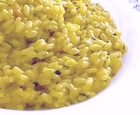|
Italian Side Milanese Creamy Rice Creamy, exquisite risotto! There may be 100's of recipes—but they all require 2 things: arborio rice and patience to make it
Liquid & Stirring: heat oil in a large skillet till hot; sauté onions for 5 minutes. Add rice, stirring to coat the grains. Add wine, slowly, 1/4 C at a time, stirring constantly, making sure rice absorbs the first addition of liquid before pouring in the second. More Liquid & Stirring: next, add the chicken broth using the same method. Stir and pour bit by bit, never allowing the rice to be covered by the liquid. When the rice absorbs the first amount, add more. You may need only 6 C, or you may need 8. It should take you about 30-40 minutes of stirring and pouring. Even More Liquid & Stirring: keep adding liquid until the rice is tender (but slightly al dente)—and very creamy. Stir in butter cubes, bit at a time. Then stir in 1/4 C of the cheese. Pour into a large bowl, top with remaining 1/4 C of cheese, and serve immediately. * This is a basic recipe. Once you master it, try others with porcini mushrooms, chicken, asparagus, pine nuts, or goat cheese. The possibilities are endless. You can also find some good commercial mixes, too—but they still require time. |
Tips & Glossary Arborio Rice: a medium-grained rice. Its high starch content yields a creamy texture and is the basis for risotto. Balsamic Vinegar: dark, thick vinegar with a sweet pungent flavor. Fermented, concentrated, and aged in wooden casks, sometimes up to 12 years. Can be pricey. Caper: salty, pickled bud of spiny shrub native to the Mediterranean region. Most prized is the non-pareil, the smallest (approx. 1/8”), though other sizes are tasty and less expensive. Formaggio: Cheese! Like France, Italy is a land of sublime cheeses, some 400 varieties. Here are some of the most widely sold in the U.S. Italian Seasoning: blend of dried herbs used in Italian cooking—marjoram, thyme, rosemary, savory, sage, oregano, and basil. Packaged commercially and found in most food stores. You can also make your own. Olive Oil: There's much more to know than is room for here. To learn all you need to know about the different grades of oil, and much, much more, head to Tanbourit. Pine Nuts: pinoli or pignoli; edible seeds of pine trees used in pesto sauce. Before cooking, release flavor by lightly browning in a heated skillet. Roasted peppers: buy or make your own: place under a broiler, or hold over a gas flame, till skin chars and blisters. Place in a closed paper bag for 15-20 minutes (to steam them). When cool, the skins slip off under water. Prosciutto: especially Prosciutto di Parma, dry-cured ham from Parma. The real deal! Cured up to 2 years, is almost sweet and very expensive. You can substitute with capicola, a delicious, light peppery ham.
|

